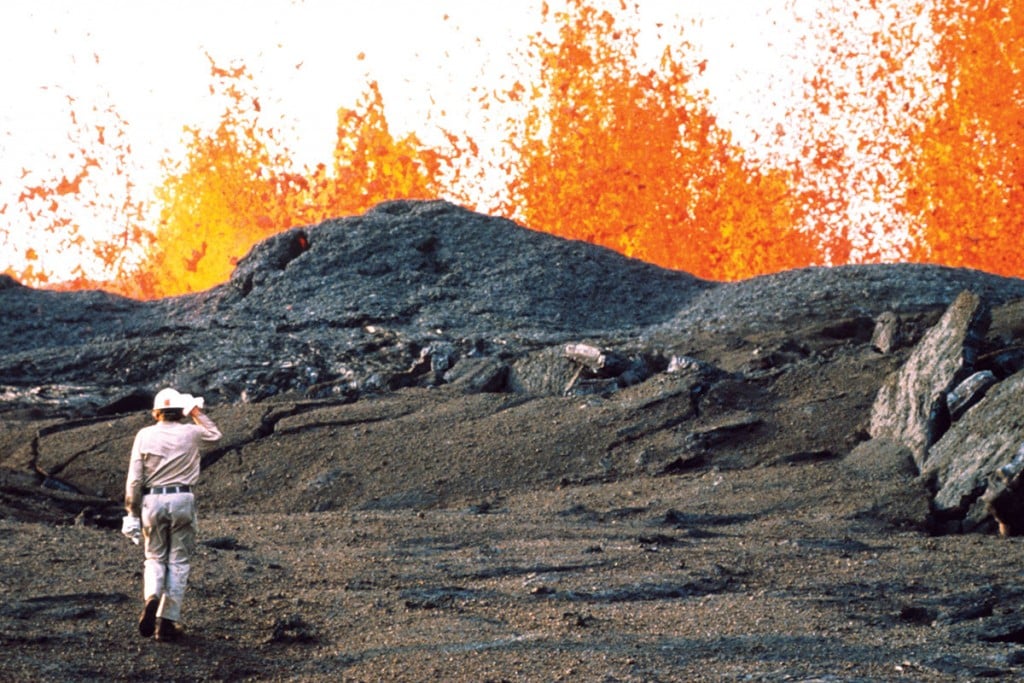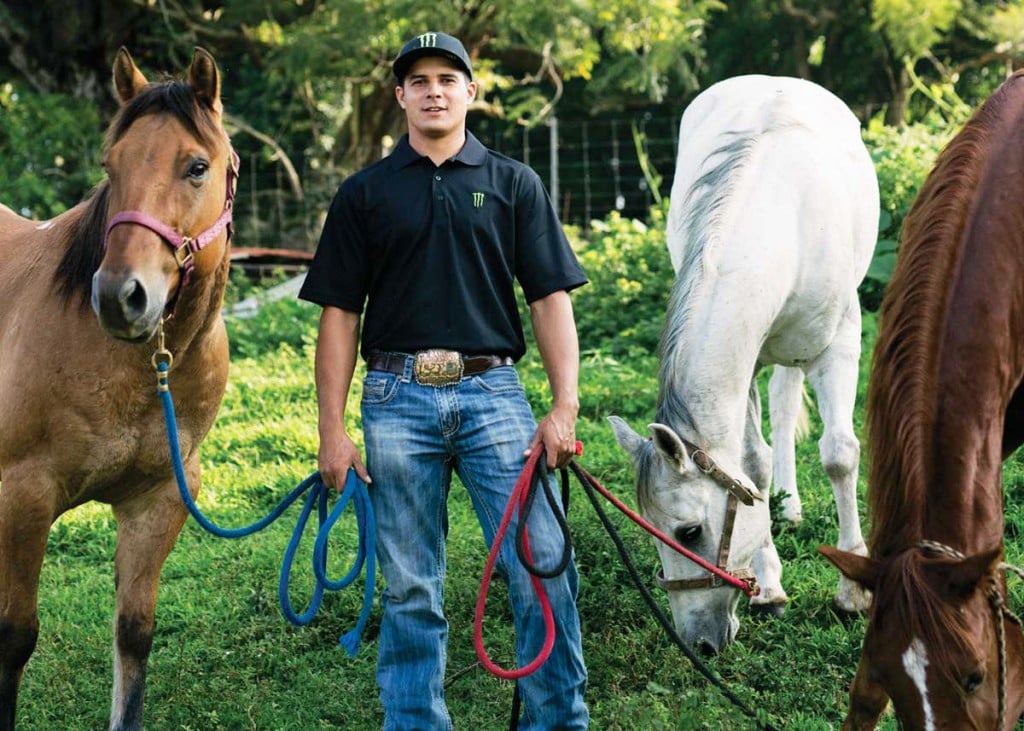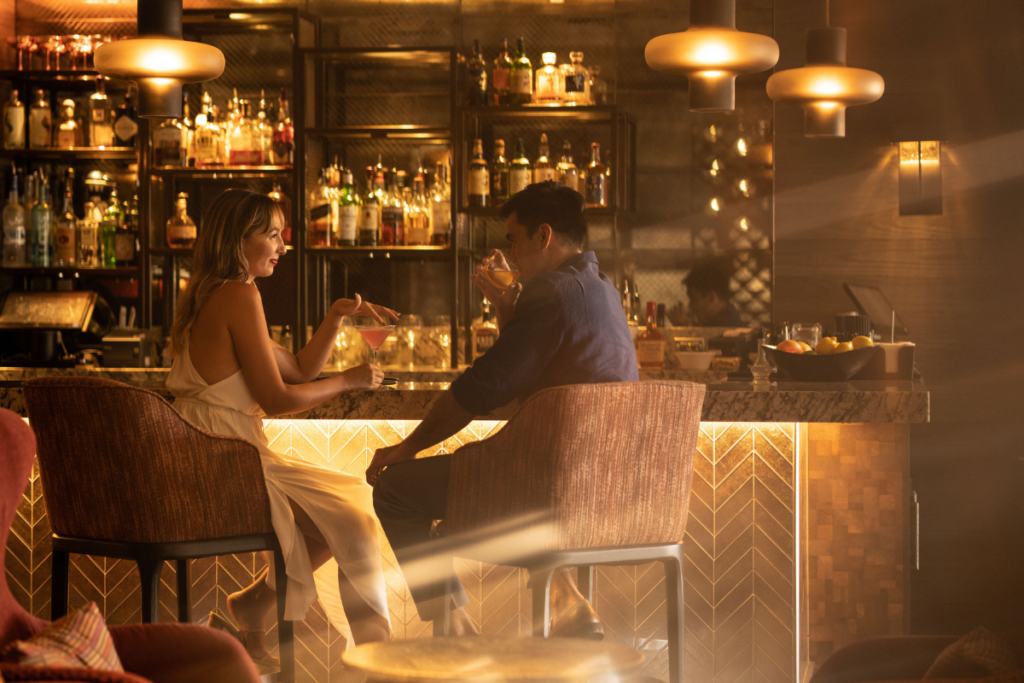What it’s like to work on the edge of an active volcano
Hawaiian Volcano Observatory scientists discuss the wonder of watching Hawaii’s natural forces at work.

A few hours before sunrise, as a lava lake swirling beneath a crack in the earth in Halemaumau crater continues to cast a scarlet glow against the dark horizon, a solitary figure walks toward Kilauea volcano’s summit caldera.
Don Swanson, a geologist studying the volcano’s eruptive history, is scooping up Halemaumau vent’s overnight ashes from 10 collection bins scattered a half mile around massive Kilauea caldera, home to the smaller pit crater. Returning to his office at nearby Hawaiian Volcano Observatory, he logs the weight of the samples, noting details such as whether the ash consists of fresh magma or old rocks. After some deskwork and a quick breakfast—there’s box of Cheerios near his bookshelves—Swanson is back in the field. His task for the rest of the morning? Measuring the thickness of aging volcanic deposits, including bulky hunks ejected violently from Halemaumau long ago.

Photo: David Croxford
Even on a relatively quiet day like this one, there’s a palpable sense of awe for Swanson and other scientists working at the venerable observatory, perched on a windswept bluff on the western edge of Kilauea summit caldera.
“It’s nothing that’s overpowering. But when I’m going down to Halemaumau, I’m sometimes thinking, ‘Look at where I am,’” says Swanson, who first set foot on this Big Island landscape more than four decades ago. “On a clear day, when you can see the terrain around Kilauea caldera and look up and see Mauna Loa, I sometimes pinch myself and say, ‘My God, am I really lucky enough to work here?’”
Hawaiian Volcano Observatory (HVO) is based at the always-fascinating, always-changing site where volcanology first surfaced as an area of modern scientific study: Kilauea volcano.

from Hawaiian Volcano Observatory.
Photo courtesy: USGS
Over the past 200 years, 4,190-foot Kilauea and neighboring 13,680-foot Mauna Loa have erupted on average every two or three years, ranking the pair among the most frequently active volcanoes in the world. Puu Oo, a cinder cone on Kilauea’s eastern flanks, which began erupting in January 1983 and hasn’t stopped since, now ranks as the second-longest-lasting Hawaiian eruption in recorded history.
Constant activity during Hawaiian Volcano Observatory’s century of existence has attracted scores of scientists—geophysicists, seismologists and more—from around the world to Hawaii, eager to study both volcanoes and big-picture ideas tied to the geological processes that have created and shaped more than 80 percent of the Earth’s surface. HVO scientists are also charged with providing the public with forecasts and precise information pertaining to volcanic and seismic activity at Hawaii’s four active volcanoes: Kilauea, Mauna Loa and Hualalai on the Big Island, and Haleakala on Maui.

Photo courtesy: USGS
Over a couple of days at the observatory, located in Hawaii Volcanoes National Park, I meet up with an affable mix of outdoorsy scientists of various disciplines, each as enthusiastic as Swanson about everything Kilauea-related. From talk of sophisticated computers monitoring volcanic breathing (a.k.a. magma-driven inflation and deflation cycles) to forensic folktales about Pele, the Hawaiian goddess of fire, who is still believed to reside in Halemaumau, I find their stories fascinating.
When I ask HVO scientist in charge, Jim Kauahikaua, about the seemingly innate lure of this place, he says it is linked to humankind’s ever-present interest in probing nature’s limitless possibilities.
“We will not come to some point and say, OK, we know all about this. That’s never going to happen,” he says. “But we can understand more and more.”

Photo courtesy: USGS
The first written historical accounts of volcanic eruptions in Hawaii date back to the 1820s and the arrival of American missionaries on the Big Island. But Kauahikaua and Swanson say Hawaii volcanic events were woven into Hawaiian chants long before that, particularly in chants about the volcano goddess Pele, who, it was believed, could start earthquakes by stamping her feet and create lava flows by digging with her paoa (divining rod). When scientists filter out chant themes ranging from sibling rivalry to loss of innocence, Kauahikaua says, “There are many geologic connections.”
Swanson has compared elements within the chants with historical timelines from Hawaiian Volcano Observatory’s earliest studies. He says that, in one case, a chant’s storyline helped prove that Kilauea’s summit caldera was formed 300 years earlier than geologists had initially thought.
“I suspect there are lots of other nuggets out there,” Swanson says of the geology-chant connection. “If people would read the chants from the perspective of telling us something real, I think they could get a lot out of it.”

Photo courtesy: USGS
Hawaii’s longest-lasting eruption in recorded history—a solid century of fiery activity within or near Halemaumau crater—was well under way by the time geologist Thomas A. Jaggar opened Kilauea’s first volcano observatory structure in 1912. (Hawaii Volcanoes National Park would open four years later.)
Kilauea’s big visitor draw then, as now, was a Halemaumau lava lake, but most comparisons end there. The lava lake of 1912, which began taking shape in the 19th century on the surface of Halemaumau’s floor, was significantly more dramatic in size—more than 1,300 feet in diameter—and visual grandeur than the largely hidden lake that has been sloshing out of visitor view beneath the crater floor since March 2008.

Photo courtesy: USGS
On a visit to the Islands in 1866, while on assignment for The Sacramento Union newspaper, American author and humorist Mark Twain wrote about Halemaumau’s blazing lava lake during a stay at the first iteration of Volcano House hotel. After an evening walk from his single-room grass shelter on the rim of Kilauea caldera to the lava lake, Twain wrote: “The greater part of the vast floor of the desert under us was as black as ink, and apparently smooth and level; but over a mile square of it was ringed and streaked and striped with a thousand branching streams of liquid and gorgeously brilliant fire!”
Only several hours earlier, Twain had been slightly less enthralled with his daylight view, writing: “I suppose that any one of nature’s most celebrated wonders will always look rather insignificant to a visitor at first, but on a better acquaintance will swell and stretch out and spread abroad, until it finally grows clear beyond his grasp — becomes too stupendous for his comprehension.”
My own first impressions of Kilauea and Halemaumau echo Twain’s.
When I arrive at Hawaiian Volcano Observatory’s lookout, on a gray and windy afternoon, I find the vast and lonely landscape striking but am disappointed by the day’s blurred visibility. After driving to nearby Volcano Village for dinner and returning in the evening, I still see lingering cloud cover over Halemaumau. But the clouds and a perpetual ash and gas plume emanating from the Halemaumau crack are now partially lit by a brilliant glow cast by the below-surface lava lake.
The view is breathtaking, and I gasp along with other camera-clutching visitors.

Photo courtesy: USGS
Operated by the United States Geological Survey in its current Uwekahuna Bluff location since 1948, Hawaiian Volcano Observatory is one of five observatories nationwide that make up the United States Geological Survery (USGS) Volcano Hazards Program, which is charged with a congressional mandate to issue timely warnings of potential geologic hazards.
Unrolling a draft version of a map charting Mauna Loa’s eruptive history, geologist Frank Trusdell explains to me the current focus of his HVO work: hazard assessment. The map is part of a set that will be used to flag potential problems for Big Island land development by answering questions such as, How often have flows come into this area? and, ultimately, Is it prudent to build here?

Photo: David Croxford
Trusdell started working at the observatory three decades ago while still a college student sorting through career options. He made up his mind to go with volcanology after witnessing a Kilauea eruption first-hand.
“Just before (the eruption), there was a lot going on. We were measuring the ground, and you could see that it was inflating and deflating,” says Trusdell, with low-key excitement. He recalls feeling vibrations under his feet when the ground finally broke out and cracked open.
“If you got close enough, you could see the gases exhaling,” says Trusdell.
Close enough to see Pele herself fuming? Whoa.
When I ask other HVO scientists whether they have ever been too close for comfort to Kilauea’s life-threatening dangers, a few dodge the question. Others shrug without much elaboration. Don Swanson, however, recounts once walking across a patch of ground that was not as solid as he had thought it would be.
“Each step was sinking down, down, down. I had gone beyond the point of return so I had to keep going,” he says, laughing lightly. “It became a kind of run, or jog, but probably lasted for just a few minutes.”

Photo courtesy: USGS
These days, field-safety requirements for HVO scientists include hard hats, “They’re good head warmers,” Swanson quips, and gas masks. Less than enamored of the masks, Swanson worries about the headgear gumming up his mobility.
“If there are a few things you want working well, they would be your ears and the ability to move quickly,” he says.
Still, Swanson knows the dangers inherent in even a tiny gust of volcanic gas coming one’s way. One day in the late 1960s, Swanson was at a vent near Halemaumau when winds shifted, sending searing fumes toward him that scorched off part of his beard.
“I had to go to a party that evening,” he says, recalling that everyone at the function took a studied look at his face and marveled at his luck. Fortunately, while his facial hair had sizzled, the fumes did not burn his skin.
Prior to Thomas A. Jaggar’s establishment of Hawaiian Volcano Observatory at Kilauea in 1912, volcano investigation around the world was largely limited to hastily organized expeditions in the aftermath of substantial eruptions.
In 1902, Jaggar, then a geologist at the Massachusetts Institute of Technology, took part in one such expedition on the island of Martinique in the West Indies. While there, he was reportedly deeply affected by an eruption at Mount Pelée that had ravaged a nearby city and killed more than 30,000 people.
With financial backing from MIT and a cadre of prominent Hawaii residents keen to support continuous volcano monitoring as a means to help save more lives and property, Jaggar founded his new observatory as a permanent laboratory, running it personally until 1919. Dozens of other HVO scientists have since continued Jaggar’s mission, leading the way in development and fine-tuning of volcano-monitoring techniques now used by observatories worldwide.

Photo courtesy: USGS
In addition to the study of volcano plumbing, HVO scientists maintain a vigilant watch on earthquake activity. Every day, between 10 and 30 earthquakes affect the Big Island, though most go undetected by the general population.
Using satellite-based tools, along with a few stalwart, old-school contraptions that Jaggar himself would likely recognize, HVO research geophysicist Mike Poland tracks changes in the ground slope on Kilauea and Mauna Loa caused by the constant movement of the earth.
A short walk from his HVO office, Poland shows me an underground vault built more than a half century ago to insulate measuring instruments from fluctuating environmental noise and temperatures. The dimly lit interior space—about as wide as a few parking places—houses a device that has pumped out tilt (ground deformation) measurements nearly every day since the mid-1950s.
As Poland explains the purpose of the instrument to me, he still seems both amused and amazed that an actual artillery shell is part of its cobbled-together design.
“Even though this is old technology, we keep it up because this record (of measurements) is amazing,” he says. Also tucked into the vault is a blinking, state-of-the-art meter that senses changes in gravity at Kilauea and issues measurements on a second-by-second basis.

in March 1983, three months after the eruption began.
Photo courtesy: USGS
When I ask Poland about recent on-the-job highlights, he recalls five consecutive days of Kilauea volcano activity last year that sent molten-lava spatter up to 160 feet in the air at a breakout fissure near Puu Oo.
“It was a perfect fissure eruption,” Poland says. Researchers were able to get close to the fresh, 1.4 mile crack in the earth and subsequent lava flow, located in a remote area of Hawaii Volcanoes National Park.
What will scientists and staff be monitoring, and what future advances in volcanology will be traced to Hawaiian Volcano Observatory, at the end of its next century? It’s hard to say, of course, though it’s expected there will be plenty to study.

Photo courtesy: USGS
Kilauea volcano shows no inclination toward tapering its current 29-year phase of continuous eruption. Mauna Loa, quiet since a 1984 breakout near its summit sent lava within four miles of Hilo town before ending, is considered long overdue for some eruptive activity of its own. And although silent since 1801 and the 17th century, Hualalai and Haleakala, respectively, remain categorized as active Hawaiian volcanoes more than likely to erupt again someday.
Swanson says studying Hawaiian volcanoes is both an honor and humbling. The only certainty that comes with working at Kilauea each day is the chance that something new or unexpected could happen, and something new could be discovered.
And that’s the way HVO scientists like it.
“The big thing that is implicit in everything I talk about is that you can never take anything for granted,” Swanson says about his work life on active volcanoes. “What is happening today might not have happened yesterday or tomorrow. The world is always changing, and a volcano is a wonderful place to see that.”


